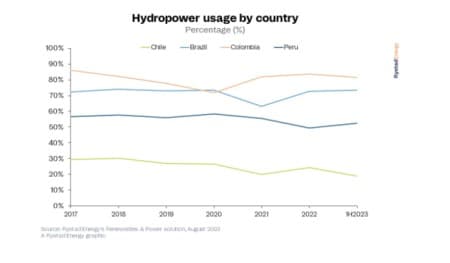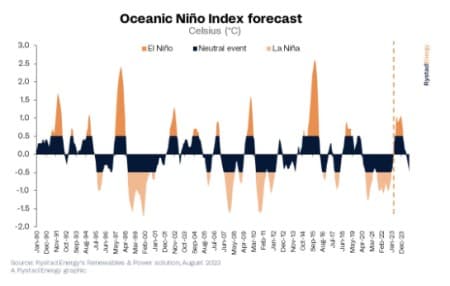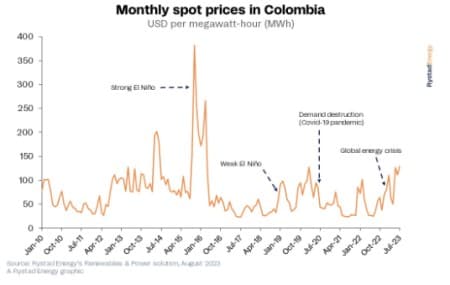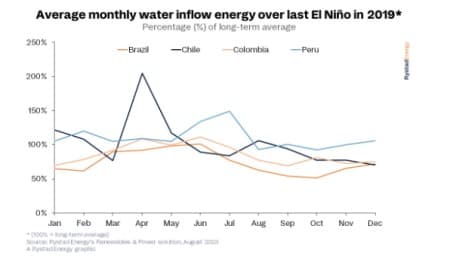South American power markets could be in for a challenging summer this year if predictions of a moderate El Niño pattern materialize, according to Rystad Energy research. The year-long climatic phenomenon is characterized by unusually warm ocean temperatures, leading to hotter weather in general and changes in rainfall patterns, impacting both power demand and hydropower generation. Hydropower is a fundamental source of electricity for many South American countries, with any drop in generation capabilities likely to trigger increased reliance on coal and natural gas, pushing up power prices for both consumers and industry. Colombia, Brazil, Chile and Peru are the most likely to be impacted, as hydro plays a major role in their respective power mixes.

The US National Oceanic and Atmospheric Administration (NOAA) predicts El Niño by monitoring climate patterns, including the Oceanic Niño Index (ONI) which measures sea surface temperatures in the central equatorial Pacific's Niño 3.4 region. Temperature anomalies must exceed +0.5°C or -0.5°C for at least five consecutive months to confirm an El Niño or La Niña event. According to the latest data, there is over a 90% probability that a moderate El Niño will begin during the next Austral summer.

Learn more with Rystad Energy’s Renewables & Power Solution.
Colombia
Colombia relies heavily on hydropower, which was responsible for more than 80% of its electricity generation in the first half of 2023, and will be the most impacted by El Niño-induced drought. During the last mild event in 2019, water inflow levels were 14% lower than average, so a tighter power market and higher prices are almost certainly on the cards. If the amount of water flowing into hydroelectric plants is 10% lower than usual until June 2024, total hydro generation in the first half of 2024 will fall by 2.8 terawatt-hours (TWh), almost 10% of the expected output. This is a sizeable drop and will lead to increased demand for thermal energy.
Colombian electricity prices have surged more than 90% over the first half of the year, rising from $50 per megawatt-hour (MWh) to $96 per MWh. This upward trend may be further intensified by a continued reduction in rainfall and water levels, which could potentially cause power prices to surpass $100/MWh. The severity and duration of El Niño will play a pivotal role in determining the extent of this escalation.
Gas prices in Colombia are already high, so increasing gas-fired dispatch will only worsen things. Less rainfall and low water levels mean only one thing for the country – higher power prices. Of course, the extent to which this will happen will depend on how severe and long-lasting El Niño is and could be balanced by other factors, including gas and coal prices in addition to demand growth.
Muched Nassif, senior renewables and power analyst, Rystad Energy

Brazil
El Niño impacts the regions of Brazil differently due to the country's size and hydro-based power mix. While the country will likely experience higher temperatures overall, the southern region may see more rainfall, while the northeastern and northern regions may experience drought. In 2019, a weaker El Niño caused water inflow energy in Brazil's northeast to be only 43% of the long-term average. However, Brazil's reservoir levels are over 80% full this time around, and a pipeline of renewable energy projects should keep the supply balance loose and ease price fluctuations next summer. Power prices should remain below $20/MWh nationwide for much of 2024, but spot prices in Brazil's northeast could be higher later in the year if hydro reservoirs are not fully replenished during the next wet season.
Chile
Chile’s hydropower capacity could improve due to higher precipitation from the north to the central area during the next Austral winter - June through August 2024 - as it could fill up reservoirs and boost hydropower capacity factors during the last quarter of 2024. However, a warmer winter could increase power demand in the country’s central area, where the load is concentrated, resulting in higher spot prices throughout the winter. In 2019, peak demand rose 2.1% due to warmer weather caused by El Niño.
Peru
Peru is also exposed to El Niño as over 50% of its power generation comes from hydro. Heavy rains are expected in the northern area of the country during the upcoming Austral summer, which is also Peru's wet season. In 2019, a mild El Niño caused water inflow energy to be about 10% higher than average. Higher hydro availability could help lower costs through 2024. Still, heavy storms could damage the transmission infrastructure and lead to higher prices in the northern area of Peru, depending on El Niño's intensity.

By Rystad Energy
More Top Reads From Oilprice.com:
- Turkey’s Appetite For Gold Increases As Lira Plummets
- Saudi Aramco Tops Profit Chart, Leaving Tech Titans In Its Wake
- Offshore Wind Red Tape Costing UK Tax Payers £1.5 Billion Per Year


















